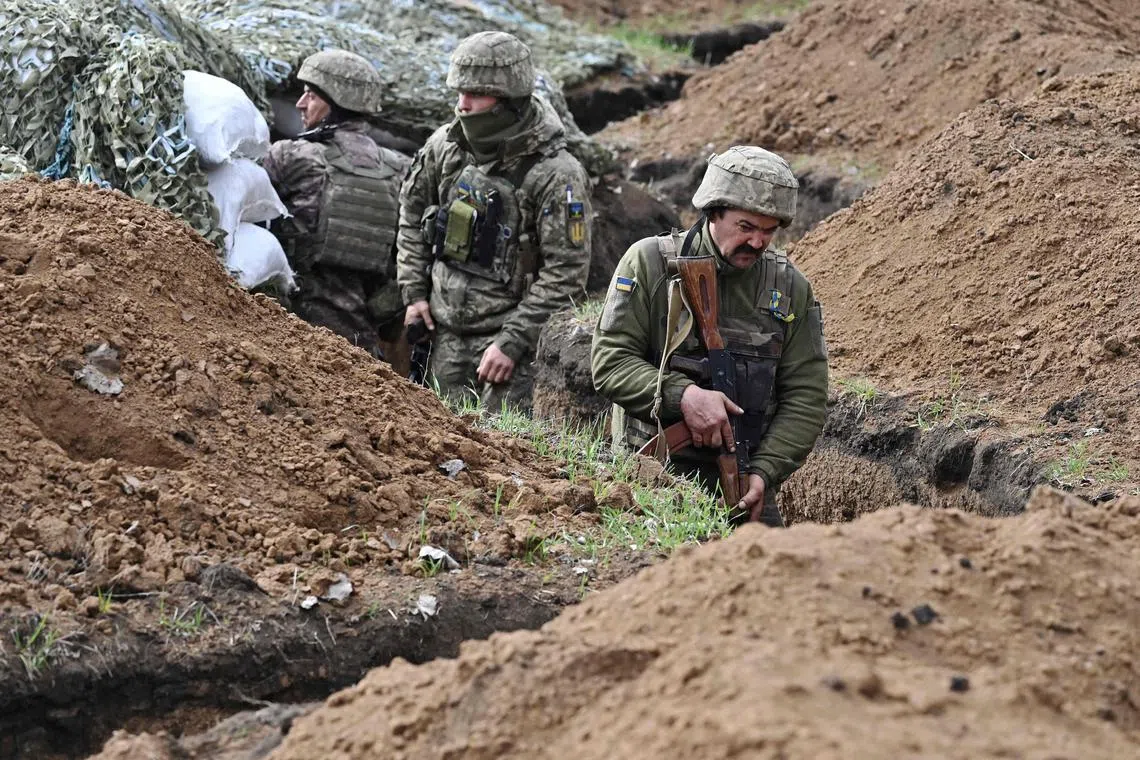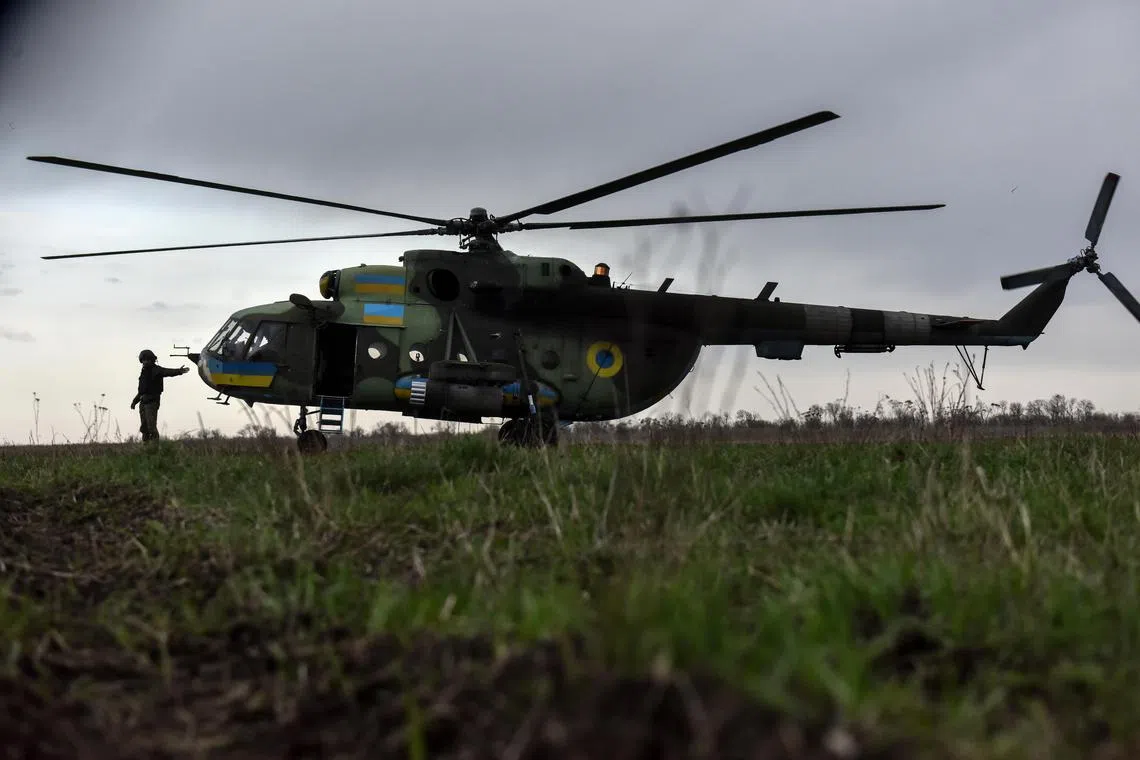Leaked documents reveal depth of US spy efforts and Russia’s military struggles
Sign up now: Get ST's newsletters delivered to your inbox

US intelligence has provided Ukraine with information crucial to defending itself, amid Russia's invasion.
PHOTO: AFP
Follow topic:
WASHINGTON – A trove of leaked Pentagon documents
The documents portray a battered Russian military struggling in its war in Ukraine
The leak, the source of which remains unknown, also reveals American assessment of a Ukrainian military that is itself in dire straits. The leaked material, from late February and early March but found on social media sites in recent days, outlines critical shortages of air defence munitions and discusses the gains being made by Russian troops around the eastern city of Bakhmut.
The intelligence reports seem to indicate that the US is also spying on Ukraine’s top military and political leaders, a reflection of Washington’s struggle to get a clear view of Ukraine’s fighting strategies.
The new documents appear to show that America’s understanding of Russian planning remains extensive and that the US is able to warn its allies about Moscow’s future operations.
The material reinforces an idea that intelligence officials have long acknowledged: The US has a clearer understanding of Russian military operations than it does of Ukrainian planning. Intelligence collection is often difficult and sometimes wrong, but the documents offer perhaps the most complete picture yet of the inner workings of the largest land war in Europe in decades.
The leak has the potential to do real damage to Ukraine’s war effort by exposing which Russian agencies the US knows the most about, giving Moscow a potential opportunity to cut off the sources of information. Current and former officials say it is too soon to know the extent of the damage, but if Russia is able to determine how the US collects its information and cuts off that flow, it may have an effect on the battlefield in Ukraine.
The leak has complicated relations with allied countries and raised doubts about America’s ability to keep its secrets. After reviewing the documents, a senior Western intelligence official said the release of the material was painful and suggested that it could curb intelligence sharing. For various agencies to provide material to one another, the official said, requires trust and assurances that certain sensitive information will be kept secret.
The documents could also hurt diplomatic ties in other ways. They make plain that the US is spying not just on Russia, but also on its allies. While that will hardly surprise officials of those countries, making such eavesdropping public always hampers relations with key partners, such as South Korea, whose help is needed to supply Ukraine with weaponry.
Republican Representative Mike Gallagher, a member of the House Intelligence Committee, said he expects Biden administration officials to brief lawmakers on the matter when Congress returns to session this week.
“It seems like a massive counter-intelligence problem, the fact that this trove of documents was leaked,” he said.
“We are talking about things that could damage our national security and CIA (Central Intelligence Agency) efforts in Europe and around the world.”
Analysts say the size of the trove is most likely about 100 pages. Reporters from The New York Times have reviewed more than 50 of those pages.
The documents appeared online as hastily taken photographs of pieces of paper sitting atop what appears to be a hunting magazine. Former officials who have reviewed the material say it appears likely that a classified briefing was folded, placed in a pocket, then taken out of a secure area to be photographed.
Senior US officials said an inquiry, launched on Friday by the Federal Bureau of Investigation, would try to move swiftly to determine the source of the leak. The officials acknowledged that the documents appear to be legitimate intelligence and operational briefs compiled by the Pentagon’s Joint Staff, using reports from the government’s intelligence community, but that at least one had been modified from the original at some later point.

Ukrainian special team members loading the body of a Russian soldier into a refrigerated wagon, in Ukraine’s Kharkiv region.
PHOTO: EPA-EFE
Much of the information in the documents tracks with public disclosures officials have made but in many cases contains more detail.
One document reports the Russians have suffered 189,500 to 223,000 casualties,
While US officials are more circumspect in describing Ukrainian losses, they have said there have been about 100,000. The leaked document says that as at February, Ukraine had suffered 124,500 to 131,000 casualties, with up to 17,500 killed in action.
Intelligence officials have repeatedly insisted that their casualty numbers are offered with “low confidence”, meaning that they are at best rough estimates. The document also notes the low-confidence assessment and further says the US is trying to revise how it assesses the combat power of the Russian military and its ability to sustain future operations.
Ukrainian officials continue to insist the documents are altered or faked. In a statement on Telegram, Mr Mykhailo Podolyak, an adviser to Ukrainian President Volodymyr Zelensky, said the leaks were meant to sow distrust between Ukraine’s partners.
Another entry talks about an information campaign being planned by the GRU, Russia’s military intelligence unit, in Africa, trying to shape public opinion against the US and “promote Russian foreign policy”.
While some of the intelligence briefs offer analysis and broad warnings of Russian plans, others are the kind of actionable information Ukraine could use to defend itself. One entry talks about the Russian Defence Ministry formulating plans to conduct missile strikes on Ukraine’s forces at specific sites in Odesa and Mykolaiv on March 3, an attack the US intelligence agencies believed would be designed to destroy a drone storage area, an air defence gun and kill Ukrainian soldiers.
In late March, Russia claimed it had destroyed a hangar containing Ukrainian drones near Odesa. Also in late March, independent military analysts said Russia attacked Mykolaiv and other Ukrainian cities, but called the shelling routine. It is unclear if the warnings provided by the US enabled the Ukrainians to take steps to mitigate the damage caused by the attacks.
Still another entry discusses a report in February disseminated by Russia’s National Defence Command Centre about the “decreased combat capability” of Russia’s forces in eastern Ukraine.

A Ukrainian pilot with an MI-8 helicopter at an undisclosed location in eastern Ukraine.
PHOTO: EPA-EFE
While the documents were compiled by the Pentagon’s Joint Staff, they contain intelligence from many agencies, including the National Security Agency, the State Department’s Bureau of Intelligence and Research, and the CIA. Some of the material is labelled as having been collected under the Foreign Intelligence Surveillance Act, or Fisa, noting that its further distribution is not allowed without the permission of the attorney-general.
One section of the documents is categorised as coming from a CIA daily intelligence update. The material in that section reveals not just who the CIA is spying on but some details on how. One intelligence report, for example, demonstrates that the CIA is using intercepted communications to spy on discussions inside Russia’s Defence Ministry.
Another CIA assessment drawing on intercepts reported that in early to mid-February, senior leaders of the Mossad, Israel’s foreign spy agency, advocated for Mossad officials and Israeli citizens to protest against judicial reforms proposed by Israel’s new government. Senior Israeli defence officials denied the assessment’s findings, and The New York Times was unable to independently verify them.
The proposed changes have generated massive public protests and prompted Prime Minister Benjamin Netanyahu to delay the proposal.
The first tranche of documents appeared to have been posted in early March on Discord, a social media chat platform popular with video gamers, according to Mr Aric Toler, an analyst at Bellingcat, the Dutch investigative site. NYTIMES

